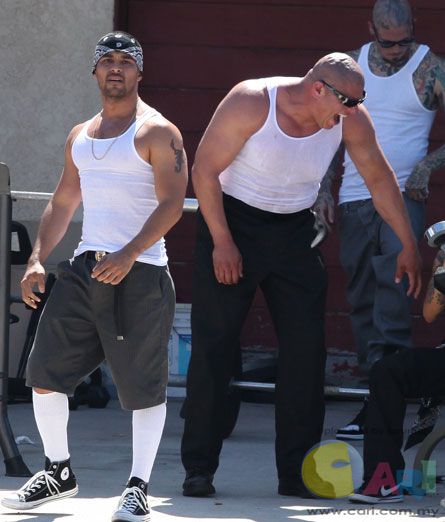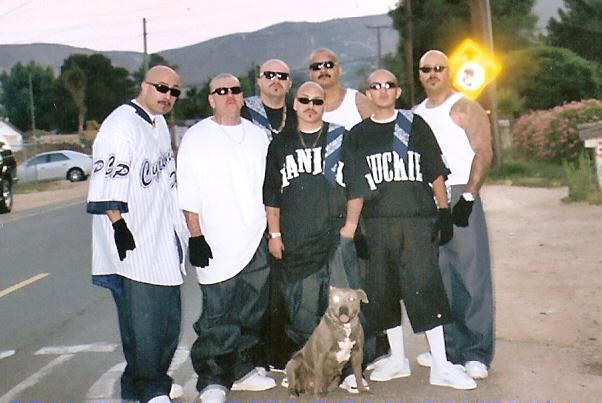|
Cholo Cholo (Spanish pronunciation: [ˈtʃolo]) is an ethnic slur created by Hispanic criollos in the 16th century. In sociological literature, it is one of castas,[1] and refers to individuals of mixed or pure Native American ancestry, or other racially mixed origin. The precise usage of "cholo" has varied widely in different times and places. In modern American usage, it most often applies to a low-income Mexican-American sub-culture and manner of dress. Historical usage The term's use is first recorded in a Peruvian book published in 1609 and 1616, the Comentarios Reales de los Incas by Inca Garcilaso de la Vega. He writes (in Spanish) "The child of a Black male and an Indian female, or of an Indian male and Black female, they call mulato and mulata. The children of these they call cholo. Cholo is a word from the Windward Islands; it means dog, not of the purebred variety, but of very disreputable origin; and the Spaniards use it for insult and vituperation". In Colonial Mexico, the terms cholo and coyote co-existed, indicating mixed Mestizo and Amerindian ancestry. Under the casta system of colonial Latin America, cholo originally applied to the children resulting from the union of a Mestizo and an Amerindian; that is, someone of three quarters Amerindian and one quarter Spanish ancestry. Other terms (mestizo, castizo, etc.) were used to denote other ratios of smaller or greater Spanish-to-Amerindian ancestry. The word xolotl (pronounced "SHOW-lotl") is an Aztec word which refers to a humanoid creature with dog features. It is from this meaning that the word "cholo" developed its negative connotation, taking on a meaning similar to "mongrel" as applied to humans. Cholo as an English-language term dates at least to 1851 when it was used by Herman Melville in his novel Moby-Dick, referring to a Spanish speaking sailor, possibly derived from the Windward Islands reference mentioned above. Isela Alexsandra Garcia of the University of California at Berkeley writes that the term can be traced to Mexico, where in the early part of the last century it referred to "culturally marginal" mestizos and Native American origin. During the War of the Pacific (1879–1883) Peruvians were despectivly referred to as "cholos" by Chilean officers. An article in the Los Angeles Express of April 2, 1907, headlined "Cleaning Up the Filthy Cholo Courts Has Begun in Earnest," uses the terms cholos and Mexicans interchangeably. The term cholo courts was defined in The Journal of San Diego History as "sometimes little more than instant slums as shanties were strewn almost randomly around city lots in order to create cheap horizontal tenements." --------------------------------------------------------------------------------------------------------------------------------------- Modern usage In modern usage in the United States, the term "cholo" usually indicates a person of Mexican or Mexican-American descent who is associated with a particular Southwestern style of dress. The term is used in Caló slang, but it in turn has infiltrated into mainstream American English use, specifically in association with American cultural subgroups such as the "lowrider" car culture, or the hip hop scene in general. The word is sometimes associated by the unfamiliar with Mexican-American gang culture, especially in popular media, but the origin and history of the modern usage is somewhat complex. Racial and cultural status, along with social class are reflected in the term cholo itself, which was adopted in California in the 1960s by youth following the pachuco tradition, as a label for that identity (Cuellar 1982). In 1571, Fray Alonso de Molina, in his Nahuatl vocabulary (Vocabulario en Lengua Castellana y Mexicana Y Mexicana y Castellana), defined the word xolo as slave, servant, or waiter. The Porrúa Dictionary defines cholo, as used in the Americas, as a civilized Native American or a half-breed or mestizo of a European father and Native American mother. The word has historically been used along the borderland as a derogatory term to mean lower class Mexican migrants, and in the rest of Latin America to mean an acculturating Indian or peasant. Despite, or because of, its long history of denigrating semantics, the term Cholo was turned on its head and used as a symbol of pride in the context of the ethnic power movements of the 1960s. Fashion stereotypes A cholo is stereotypically male, depicted as wearing loose fitting khaki pants or shorts, with white knee-high socks, creased jeans, so-called wifebeater white sleeveless athletic shirt, and button-front shirts, commonly plaid and flannel. Some wear a Baja Jacket. Cholos are known for starching and pressing their pants and shirts. Cholos often wear military-style webbed belts.[citation needed] Cholos in the 1990s and 2000s frequently have their hair buzzed very short, though some continue to have the more traditional slicked-back hair, sometimes held in place by a hairnet or a bandana.       Footwear originally included Stacy Adams dress shoes, and "biscuits"(pointy toed dress shoes). Modern cholos tend to wear athletic shoes, such as Converse, Nike Cortez, Stan Smith brand Adidas, slip-on house shoes or Huarache sandals. Popular "Cholo" brands include Dickies, Ben Davis, Joker, Lowrider, and Bighouse. Some cholos, particularly older cholos (veteranos) or cholos wishing to adopt a more traditional look,wear formal wear inspired by zoot suit fashion, including dress shirts with suspenders, and fedora hats, but may still retain cholo elements such as a bandana or hair net. Cholos are not traditionally found in rural areas. In South Texas, cholos are sometimes referred to as chucs or chukes. This term is short for pachucos. Tejano cholos typically make heavy use of starch on their pants but so do traditional Tejanos.    This designation may also be associated with black ink tattoos, commonly involving calligraphy and art. A cholo might also stereotypically own a lowrider. Another staple of cholo fashion is long hair tied into braids as depicted by actor Danny Trejo. "Cholas" and "Cholitas" are females who adopt similar fashions. Cholas may wear clothing that is very similar to Cholos, such as Dickies pants or baggy jeans, tank-tops or t-shirts, as well as halter-tops or blouses. Cholas in the 1980s and 1990s often curled their hair and teased it upward, with hair gel or hairspray (the so-called "Scare-do"), and often wore black or dark lipstick and bright eyeshadow, often with penciled-in eyebrows. However, they adopted a more classic look as fashion styles changed in the late 1990s. In the past, some cholas were the sisters or girlfriends of cholos, but in recent years, increasingly form gangs or cliques in their own right. However, individuals who dress in the cholo style aren't necessarily associated with gang culture. Some teens will dress in this style during a passing phase in high school. Others simply grew up with the style. More recently, chola fashion has received mainstream attention in urban and popular fashion. Singers such as Fergie and Gwen Stefani have cited the chola look as a fashion influence. Tattoo artist and glamor model Kat Von D has also mentioned that her style of make-up was influenced by the chola look. Cholo image in media There is a reference to "The Cholo" in Assault on Precinct 13 (1976), although it is used to refer specifically to a blood oath instead of a Mexican person. LA punk rock band The Dickies recorded "I'm A Chollo" for their 1979 album "Dawn of the Dickies". The Crossover Thrash band Suicidal Tendencies has sported a cholo look since the 1980s. In the 2004 film Napoleon Dynamite, Nano and Arturo De Silva play characters simply referred to as "Cholo No. 1" and "Cholo No. 2". In the videogame Grand Theft Auto: Vice City Stories, there is a street gang called the Cholos who resemble the stereotypical gangster image of a Cholo. The term gained even further notoriety in 2007 in the United States with the song "Lean Like a Cholo" by Down AKA Kilo. Fergie's music videos "London Bridge" and "Glamorous" feature backup dancers dressed as cholas. Gwen Stefani adopted the chola image in her music videos "Luxurious" and "Hollaback Girl".
In the FOX TV series American Dad, in the episode "Brains, Brains and Automobiles", Roger gets his own apartment in a low-income neighborhood and when Stan and Francine come to visit, he complains that a group of cholos robbed him and he said he keeps a box of "Chocodiles" in the freezer for in case they come back. The 2009 film La Mission, starring Benjamin Bratt, is an authentic representation of the style, language, cars and music associated with the Cholo culture. The 2009 movie Bring It On: Fight to the Finish, starring Christina Milian, featured a group of cholos who dressed in the cholo style. The word is also mentioned in a few lines of the Lady Gaga song "Born This Way". |
|
9
 Bagus |
8
 Marah |
1
 Terkejut |
2
 Sedih |
6
 Lawak |
4
 Bosan |

Anonymity

Anonymity

Anonymity

Anonymity

Anonymity

Anonymity

Anonymity

Anonymity

Anonymity

Anonymity

Anonymity

Anonymity

Anonymity

Anonymity

Anonymity

Anonymity

Anonymity

Anonymity

Anonymity

Anonymity

Anonymity

Anonymity

Anonymity

Anonymity

ADVERTISEMENT